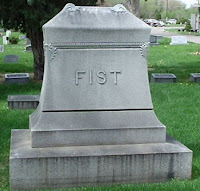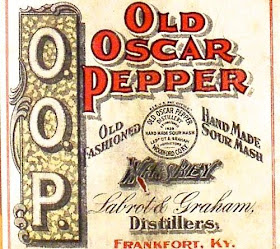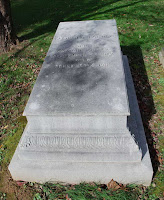Martin was born in March 1842 in Maysville, Kentucky. He was the fourth in a line of six children from William and Margaret Martin, both immigrants from Ireland who had settled for a time in Pennsylvania before making their way to Kentucky. The 1860 census found them living in Maysville where William and his eldest son, John, were engaged in the shoemaker’s trade. Edward’s occupation was listed as “clerk.” He married at only 20 years, his bride the 19-year-old Mary Elizabeth Ricketts, a native Kentuckian. They would have two children, Lulu, born in 1865 and Edward R., 1867.
In 1863, with Mary Elizabeth, Martin left Maysville, and headed 650 miles west through Kentucky and Missouri to Kansas City. He must have been strongly motivated because at that stage of the Civil War armed conflict was frequent in both states, with danger from “bushwackers” common in Missouri. A year later the Battle of Westport was fought at Kansas City, a pivotal conflict that ended the last major Confederate offensive west of the Mississippi River. Martin’s occupation during those early years has gone unrecorded but his subsequent activities suggest he was working in the whiskey trade, likely for one of the Kansas City’s several liquor houses.
 In 1868, Martin struck out on his own, listed in local business directories as the proprietor of E. L. Martin & Co., Wholesale Liquor Dealers. He had as a partner a friend from Maysville, J. A. Loughbridge. His early address was at 404 Delaware Street, near West Fourth, the latter street shown here as it looked at that time. The post-Civil War period brought population growth and general economic good times to Kansas City, including a proliferation of saloons needing supplies. Early letterheads from the company emphasized that the partners were “late of Maysville, Ky.” thereby suggesting ties to Kentucky whiskey quality. The 1870 federal census found Edward living in Ward 2 of Kansas City with his family, his occupation given as “liquor merchant.” Living with the Martins was a younger brother, George Martin, who was clerking in his store.
In 1868, Martin struck out on his own, listed in local business directories as the proprietor of E. L. Martin & Co., Wholesale Liquor Dealers. He had as a partner a friend from Maysville, J. A. Loughbridge. His early address was at 404 Delaware Street, near West Fourth, the latter street shown here as it looked at that time. The post-Civil War period brought population growth and general economic good times to Kansas City, including a proliferation of saloons needing supplies. Early letterheads from the company emphasized that the partners were “late of Maysville, Ky.” thereby suggesting ties to Kentucky whiskey quality. The 1870 federal census found Edward living in Ward 2 of Kansas City with his family, his occupation given as “liquor merchant.” Living with the Martins was a younger brother, George Martin, who was clerking in his store. Even as he was building his business, Martin was becoming increasingly recognized in local commercial circles as a “comer.” In 1871, at the age of 29 he was elected as secretary of the city’s Board of Trade, the building shown here. That provided a political springboard and as a Democrat he was elected a councilman and in 1873 mayor of Kansas City. His year in that office proved to be an active one that included enlarging the city limits, reorganizing the ward system, establishing free mail delivery, constructing the water works, and creating a horse-drawn trolley line. The quality of his service was such that two years later Martin was elected to the Kansas City Board of Education where he served from 1875 to 1896 — twenty-one years.
Even as he was building his business, Martin was becoming increasingly recognized in local commercial circles as a “comer.” In 1871, at the age of 29 he was elected as secretary of the city’s Board of Trade, the building shown here. That provided a political springboard and as a Democrat he was elected a councilman and in 1873 mayor of Kansas City. His year in that office proved to be an active one that included enlarging the city limits, reorganizing the ward system, establishing free mail delivery, constructing the water works, and creating a horse-drawn trolley line. The quality of his service was such that two years later Martin was elected to the Kansas City Board of Education where he served from 1875 to 1896 — twenty-one years.
Those activities do not appear to have affected his business growth. Likely seeing a need for more management help, in 1872 Marin hired a local, C. G. Perrin, and two years later made him a partner, Loughbridge having left the firm earlier. The company name became Martin, Perrin & Co. Eventually Edward would bring in as a third partner T. E. Gaines, possibly from the Gaines distilling family, who had married his daughter, Lulu.
 As his business grew, Martin moved regularly to larger quarters, initially along Delaware Avenue but in the mid-1880s to 300-302 W. Sixth Street. Shown right, it was a four-story building that allowed him to operate as a “rectifier.” blending, bottling and marketing his own brands of whiskey. They included “Martin 4X,” “Martin’s Old Standard.” “Martin’s Private Stock,” “Martin's Special Reserve.” ”Martin's XX,” "Martin's XXX,” "Martin's XXXX” and other labels. As its founder and president Martin called this operation the Kansas City Distilling Co., as shown on a trade card here.
As his business grew, Martin moved regularly to larger quarters, initially along Delaware Avenue but in the mid-1880s to 300-302 W. Sixth Street. Shown right, it was a four-story building that allowed him to operate as a “rectifier.” blending, bottling and marketing his own brands of whiskey. They included “Martin 4X,” “Martin’s Old Standard.” “Martin’s Private Stock,” “Martin's Special Reserve.” ”Martin's XX,” "Martin's XXX,” "Martin's XXXX” and other labels. As its founder and president Martin called this operation the Kansas City Distilling Co., as shown on a trade card here. Martin also claimed ownership of Crystal Springs Distillery, even advertising it on the side of his building. This facility was one of two independent distilleries that operated on the same site on the east side of First Street at Magnolia Avenue in Louisville, Kentucky. Insurance records indicate that the distillery was of frame construction with a metal or slate roof, with at least three warehouses, one of brick constructions. Records do not indicate Martin’s ownership but he may well have had a strong financial interest and a guaranteed supply of Crystal Springs whiskey.
Martin also claimed ownership of Crystal Springs Distillery, even advertising it on the side of his building. This facility was one of two independent distilleries that operated on the same site on the east side of First Street at Magnolia Avenue in Louisville, Kentucky. Insurance records indicate that the distillery was of frame construction with a metal or slate roof, with at least three warehouses, one of brick constructions. Records do not indicate Martin’s ownership but he may well have had a strong financial interest and a guaranteed supply of Crystal Springs whiskey.
By 1888 Martin, Perrin & Co. was being attested in a “History of Kansas City” as its oldest liquor house and credited with pushing the city’s trade into new locales: “It has a large corps of travelers covering the entire territory and makes consignments to Missouri, Nebraska, Arkansas, Texas, Colorado, New Mexico, Arizona, Wyoming and Dakota.”
 With his growing wealth and others to run his liquor interests, Martin turned increasingly to the role of financier. It was there that he met Arthur E. Stillwell, shown right, who was head of a trust company in Kansas City, the second only in Missouri. A investor and director was Edward Martin, whom Stillwell hailed as “a man who saved the city’s credit by paying out of his pocket the interest on the city’s bonds when it had no funds to meet it.” Although I have not been able to uncover dates or details of this transaction, records show city school bonds in payment arrears in the 1880s while Martin was serving on the school board.
With his growing wealth and others to run his liquor interests, Martin turned increasingly to the role of financier. It was there that he met Arthur E. Stillwell, shown right, who was head of a trust company in Kansas City, the second only in Missouri. A investor and director was Edward Martin, whom Stillwell hailed as “a man who saved the city’s credit by paying out of his pocket the interest on the city’s bonds when it had no funds to meet it.” Although I have not been able to uncover dates or details of this transaction, records show city school bonds in payment arrears in the 1880s while Martin was serving on the school board.
In 1887 Martin told Stillwell that he had a franchise for building a belt railroad around Kansas City but could not raise the financing and the franchise would run out in less than a week. Stillwell, from a railroad family, took the whiskey man in tow, immediately setting out for Philadelphia and the money men there. The two formed a syndicate, raised the money and began work on the line before the deadline. The suburban line was the nucleus of what would become the Kansas City Southern Railway, extending into Mexico. Today it is the smallest and third-oldest Class I railroad line in America. An early engine of the line is illustrated below.
Perhaps heartened by this success, the same year, Martin plunged into land development. He purchased acreage immediately along the Missouri and Kansas border adjacent to Kansas City, platted it with John Lipscomb, and sold off the lots. Shown here, the community originally was named Tilden, for the Democratic presidential candidate narrowly defeated in the election of 1876. Because another town in Missouri also was named Tilden, the name reverted to the founder — Edward L. Martin. This unincorporated town was annexed to the Kansas City in 1963. The neighborhood is still known as Martin City.
Although Martin’s liquor business appears to have survived until 1917, he increasingly was turning to other pursuits. By 1900 he was being identified as a banker by the census and in city directories as president of the Guardian Trust Company. In 1905 those directories indicate that he and son, Edward R., had their offices in Room 551 of the Gibraltar Building while operating the Eli Mining & Land Company.
 In 1912 Edward L. Martin died at age 70 and was buried in Elmwood Cemetery. His monument is shown here. His widow, Mary Elizabeth, would join him there in 1933. In the community he created, each year a race is held in March that I assume is in honor of this remarkable shoemaker’s son, public-spirited citizen, and liquor dealer. It is called the “Martin City Whiskey Run.”
In 1912 Edward L. Martin died at age 70 and was buried in Elmwood Cemetery. His monument is shown here. His widow, Mary Elizabeth, would join him there in 1933. In the community he created, each year a race is held in March that I assume is in honor of this remarkable shoemaker’s son, public-spirited citizen, and liquor dealer. It is called the “Martin City Whiskey Run.”












































